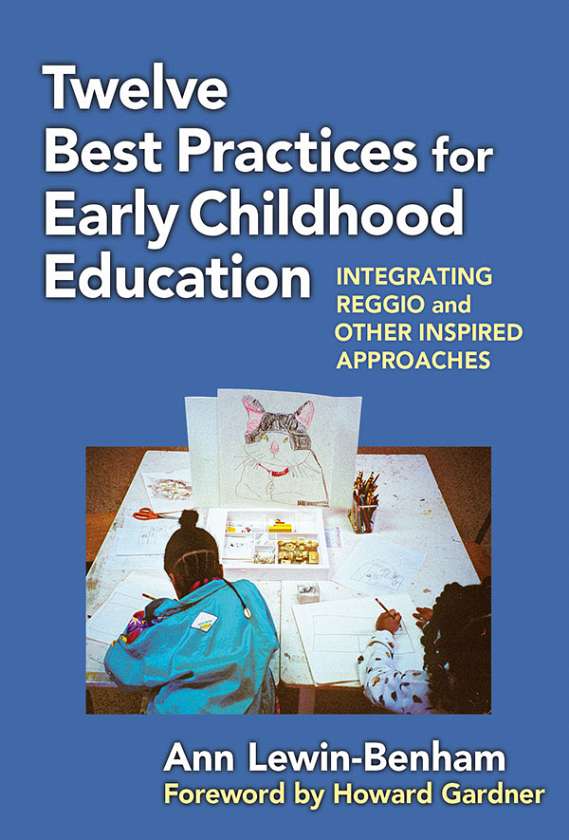Professors: Request an Exam Copy
Print copies available for US orders only. For orders outside the US, see our international distributors.
Foreword by: Howard Gardner
Publication Date: June 20, 2011
Pages: 224
Series: Early Childhood Education Series

In her new book, popular author Ann Lewin-Benham draws on her intimate knowledge and experience with the Reggio Approach to present 12 “best practices” inspired not only by Reggio, but also by play-based and Montessori approaches to early childhood education. These practices are demonstrated, one per chapter, with scenarios from classrooms, dialogues of children and teachers, and work samples showing the outcome of using each practice. Used together, the 12 best practices offer a new framework for early education.
Written in the accessible style that her readers appreciate, this book expands on Lewin-Benham’s earlier works by showing the foundations for teachers to practice the Reggio Approach in their own settings. It introduces several new techniques: fostering language skills through Meaningful Conversation, designing inspiring environments, switching from a scheduled to an Open Flow day, using materials to build brain networks and stimulate Significant Work, and much more.
This important resource also includes a self-assessment tool, EXCEL, to assist you in examining your practices and those of your school. All chapters include key points and questions to help readers think more deeply about the material presented.
Ann Lewin-Benham founded and for 20 years directed the Capital Children’s Museum in Washington, DC, where she also founded and directed the Model Early Learning Center, the only U.S. preschool accredited by Reggio educators. Her books include Possible Schools; Powerful Children; Infants and Toddlers at Work; Twelve Best Practices for Early Education; and What Learning Looks Like (with Reuven Feuerstein). For information about Ann’s teacher workshops visit her website: AnnLewin-Benham.com.
“Lewin-Benham offers joyful, grounded, and practical counsel to early childhood teachers… totally delightful and thoroughly helpful!”
—Sharon Lynn Kagan, Teachers College, Columbia University
“I predict that you’ll place this book alongside those educational readings that you value most.”
—From the Foreword by Howard Gardner
“Once again, Ann Lewin-Benham has demonstrated the depth of her knowledge and understanding of the field of early childhood education and the sharp insights of one who accommodates the intersection of theory and practice; one who has created and supported Reggio-inspired early childhood programs that value children’s time and intelligence; and one who has repeatedly sounded the clarion call for the nation to give our young children the schools they deserve. This book is a must-read for all who care about doing the right thing for children.”
—Maurice Sykes, Executive Director, Early Childhood Leadership Institute, University of the District of Columbia
Foreword: Ann Lewin-Benham’s Vade Mecum, by Howard Gardner
Acknowledgments
Introduction
Changing Practices
The Book’s Content
Breaching the Reggio/U.S. Divide
Chapter 1. When Belief Drives Practice
Cultural Context of Reggio Emilia
Reggio’s Unique Beliefs and Features
Correlations: Best Practices and the Reggio Approach
The Structure Supporting Reggio Practices
Conclusion: Using Reggio and Other Best Practices
Chapter 2. Developing Self-Regulation
Becoming Self-Regulated
The Reggio Approach
Montessori’s "Normalizing" Method
A Scripted Kindergarten
Scheduled Early Education
The Model Early Learning Center’s Techniques
Conclusion: Self-Regulation—The Basis for Learning
Chapter 3. Using Documentation to Gain Parents' Trust
What Is Documentation?
Documentation as a Magnet for Parents
A Project Emerges
Robust Parent Involvement
Panels as Planning for Curriculum
Conclusion: Documentation—A System for Listening
Chapter 4. An Open Flow Day
Essential Features of an Open Flow Day
How Open Flow Looks
Moving Toward Open Flow
Conclusion: Differently Organized Days
Chapter 5. The Environment Is the Curriculum
When Design Fails to Support Children
Exemplary Features of Reggio Classrooms
Thinking About Design
Developing an Aesthetic Sense
Designing or Redesigning a Classroom
Conclusion: A New Take on Environment
Chapter 6. The Art of Meaning-Full Conversation
Defining Conversation
Holding Focused Conversations
Conversation Punctuates a Project
Techniques in the Conversation Tool Kit
The Impact of Focused Conversation
Conclusion: Conversing Toward Literacy
Chapter 7. Intentional Teaching
What Is Intention?
Intention in Reggio Teachers
Conclusion: The Teacher’s Roles in Action
Chapter 8. Materials and Human Development
The "Languages" of Materials
Materials and Brain Development
"Framing" and the Brain's Attention Systems
Triggering Visualization and Imagination
Conclusion: The Romance of Materials
Chapter 9. Materials and Relationships
Why Materials Matter
Finding Good Materials
Asking Families to Help
Materials and Cognition
Conclusion: Finding Relationships
Chapter 10. Documentation
Walls as Curriculum
Documentation of an Experience
Walls That Encourage Mindful Activity
Documentation at Work
Using Documentation Reflectively
Conclusion: Walls That Intrigue Parents
Chapter 11. Assessing Children’s Progress
Evaluation
Assessment
Authentic Assessment
Roadblocks to Authentic Assessment
Reconciling Authentic Assessment and Standardized Testing
Effectiveness of Authentic Assessment
Conclusion: "Proof" Is Not Attainable
Chapter 12. Significant Project Work
An MELC Story
A Reggio Story
The Contrast
Conclusion: Bucking Cultural Imperatives
Chapter 13. EXCEL
Understanding the Acronym EXCEL
Putting EXCEL to Work
Using EXCEL to Rate Yourself
Conclusion: Best Practices and Significant Work
Glossary
References
Index
About the Author
Professors: Request an Exam Copy
Print copies available for US orders only. For orders outside the US, see our international distributors.